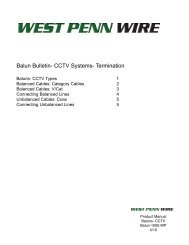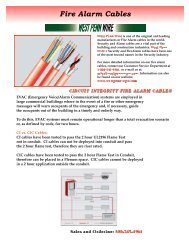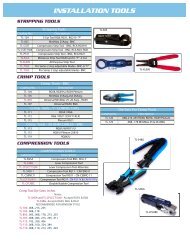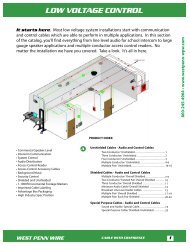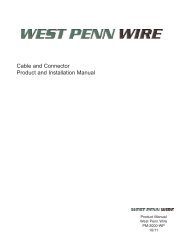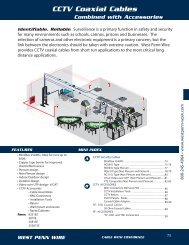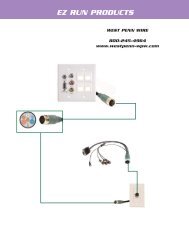You also want an ePaper? Increase the reach of your titles
YUMPU automatically turns print PDFs into web optimized ePapers that Google loves.
Fluoropolymers<br />
These compounds are commonly used for high temperature applications<br />
and areas such as plenums that require flame retardancy<br />
and low smoke characteristics. The NEC mandates the use of these<br />
types of materials in ducts, plenums, and other space used for<br />
environmental air. Using these types of compounds will allow for<br />
reduced cost in installation because there is no need to install<br />
conduit.<br />
Halar ®<br />
A premium insulation with excellent electrical and mechanical<br />
properties. This compound offers a stable low dielectric constant<br />
over a wide range of frequencies. It is also chemical resistant, abrasion<br />
and impact resistant, and can withstand high temperatures.<br />
Teflon ®<br />
A premium insulation with excellent electrical and mechanical<br />
properties. This compound is widely used as a solid or foamed<br />
dielectric, allowing for an extremely low loss cable. This compound<br />
can withstand high temperatures and has low flame and<br />
smoke characteristics.<br />
Copolymer<br />
Polyvinylidene Fluoride (PVDF). This compound has rather poor<br />
electrical properties. However, this compound has a very high temperature<br />
rating and excellent mechanical properties such as cutthrough<br />
resistance, corrosion resistance, abrasion resistance, and<br />
high tensile strength.<br />
Elastomers<br />
This is a group of compounds that are "rubber-like" in appearance.<br />
They can be compressed or even stressed and will snap back to<br />
their original shape with the release of tension.<br />
TPE - Thermo-Plastic Elastomer<br />
Shielding<br />
There are basically three types of shielding techniques: foil shielding,<br />
braid shielding, and combination shielding. Shielding is utilized<br />
to prevent radiation and signal loss of high frequencies used<br />
in electronic circuits and to reduce EMI/RFI interference. However,<br />
shielding tends to increase the overall capacitance of the cable.<br />
Foil Shield<br />
Foil shields are usually made of a thin layer of aluminum bonded<br />
to a polyester film. A foil shield allows for 100% coverage if<br />
applied with an appropriate overlap construction. A drain wire is<br />
used in conjunction with the foil shield to connect the shield to<br />
ground. This permits extraneous signals to be “drained off” to<br />
ground. It is very good in reducing Radio Frequency (RF) interference,<br />
but does not perform as well in blocking Electro Magnetic<br />
Interference (EMI). Foil shields do provide easy termination and<br />
low cost protection, although fragile (low tensile strength and<br />
impact resistance).<br />
BiFoil<br />
This type of foil shield allows for added protection by increasing<br />
the metallic coverage without adding increased thickness to the<br />
diameter of the cable. Mainly used in coaxial cable, the BiFoil<br />
shield is an aluminum-polyester-aluminum tape with 100%<br />
coverage.<br />
Bonded BiFoil<br />
This type of foil shield has the same aluminum-polyester-aluminum<br />
construction as the BiFoil shield, but is also bonded to the<br />
dielectric with adhesive. This allows for better shielding capabilities<br />
as well as providing excellent ease of stripping because the foil<br />
does not pull away from the dielectric.<br />
Braid Shield<br />
Braided shields can be constructed in various coverages, 95–98%<br />
being about the highest coverage available with this type of shielding.<br />
The material can be bare copper, tinned copper, or aluminum.<br />
Depending on the amount of coverage, braid shields reduce EMI<br />
interference well, but are not as reliable in the RF range. Braid<br />
shields also allow for a much lower shield D.C. resistance than foil<br />
shields.<br />
Technical Reference<br />
Basic Cable Construction<br />
Combination Shielding<br />
This technique offers the best of both types of shielding. First, a foil<br />
shield is applied around the primary conductors and then a braided<br />
shield is placed on top of the foil shield. This allows for greater coverage<br />
in blocking both EMI and RFI signals while allowing for a low<br />
D.C. resistance in the shield. There are also various versions of this<br />
basic technique such as triaxial and quad shielding.<br />
Foil/Braid<br />
This is the most common type of combination shielding. The aluminum<br />
foil is wrapped around the cabled or twisted primaries and<br />
then a braided shield is applied over top<br />
of the aluminum foil. The metallic side of the foil shield is usually<br />
in contact with the braid. The braid is then used for shielding as<br />
well as ground termination eliminating<br />
the need for a drain wire.<br />
Triaxial - A Braid-Separator-Braid combination shield construction.<br />
Quad - A Foil-Braid-Foil-Braid combination shield construction. This<br />
provides for maximum shielding against EMI/RFI interference.<br />
Jackets<br />
The cable jacket is for strength, integrity, and overall protection of<br />
the primaries and/or shield inside the jacket. There are a variety of<br />
jacketing materials that are used in cable construction. Standard<br />
compounds and special variations of these compounds can be used<br />
in making the jacket. Selecting a cable with the proper jacket for the<br />
environment it will be installed in is an important consideration.<br />
Environmental parameters that should be considered include temperature<br />
variations, chemical reactance, sunlight resistance, mechanical<br />
and abrasion impact. Jackets are usually made up of the same<br />
material as insulation used on primaries. To learn more about the<br />
various compound properties, please refer to the Insulation Section.<br />
Jacket<br />
Insulation<br />
Braid<br />
Shield<br />
Conductor<br />
Foil<br />
Shield<br />
185



